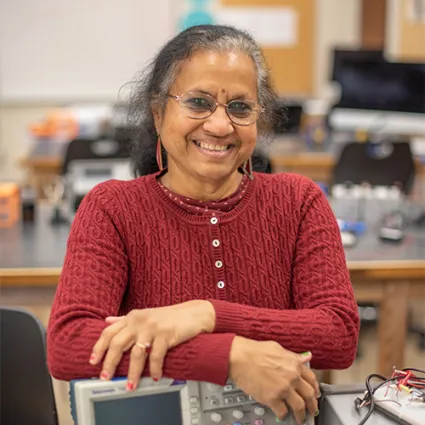Nalini Easwar
Professor Emerita of Physics

Biography
Nalini Easwar's field of interest is experimental condensed matter physics, specifically complex fluids such as macromolecular solutions, colloids and granular systems. Her current work focuses on different aspects of dense granular flow.
After completing her master's in nuclear physics from the University of Bombay, India, Easwar taught for several years at the undergraduate level in India before beginning graduate school at the University of Pittsburgh. After teaching at Amherst College and doing postdoctoral research at the University of Massachusetts, she joined Smith in 1987. She has collaborations with the Polymer Science and Engineering department at the University of Massachusetts. Easwar has research funding from the NSF supported Materials Research Science and Engineering Center (MRSEC) at the University of Massachusetts. The project on the study of force propagation in flowing granular media was in collaboration with the physics department at the university and this collaboration continues. Currently, the experiments focus on the effect of wall friction on 2D and 3D hopper flows.
Easwar loves chocolate, music, long walks, hiking, Bollywood songs and dances, and she is a persevering student of West African dance.
Research
Nalini Easwar’s research is in the field of complex fluids, specifically in the study of dry dense granular flows. It is just over a couple of decades since physicists began working on the problem of granular materials, spurring the field of soft matter physics. Quoting Nobel physicist Leo Kadanoff, “It is natural to ask whether the same equations, concepts, and theories that work for molecular material also apply to the granular form of matter."
Sand is but one example of a large range of granular systems around us.
Granular matter is everywhere! Cereals, pharmaceutical pills, grains in a silo and dry snow are just a few examples. This matter is ubiquitous and plays an important role in industry, agriculture, construction and geology. Despite their importance in many aspects of our lives, our understanding of these systems is still limited. The study of such complex fluids is a new frontier for physicists. There are other examples of materials that are complex and have fascinating nonintuitive properties, like shaving cream, cornstarch and even chocolate.
In her lab (described as an interesting beach!), students work on exploring flows of grains from 2D and 3D hoppers, studying aspects of stress propagation, velocity—force correlations, shear zones and jamming. Techniques involve video imaging of the flows to map the velocity field coupled with measurements of flow rates and stress at the boundary of the flows.
Lab Projects & Videos
Robotic Gripper Arm
Jenny Bahn '18 and Sarah Thalheimer '18 (AEMES and STRIDE students) built a gripper arm with a balloon filled with coffee grinds. When the balloon engulfs the object and the air is pumped out, the granular medium tightens around the object and the force chains in the granular medium grab the object. One balloon with coffee grinds fits all kinds of shapes of objects! Look at the videos where Sarah picks up a coffee mug and another small object from the table.
Granular Jets
A spectacular jet emerges after an object falling on a granular bed gets buried in the bed. Watch the jet as a steel ball is dropped onto a bed of loosely packed (fluidized) bed of baking soda. (Setup and video by Jenny Banh '18 and Sarah Thalheimer '18 in Easwar's lab at Smith College.)
Oobleck Fun
Corn starch and water form a shear thickening fluid: It hardens when sheared, making it possible to slam on oobleck (it feels like a solid) as well as run on it as it hardens under your feet. Just don't stand still on the tank of oobleck
Posters: Collaborations
Education